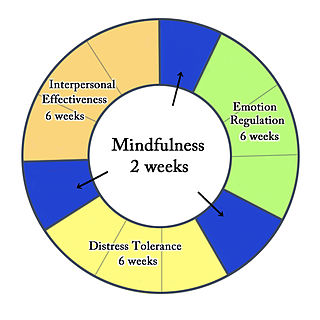Related Research Articles

Cognitive behavioral therapy (CBT) is a psycho-social intervention that aims to reduce symptoms of various mental health conditions, primarily depression and anxiety disorders. CBT focuses on challenging and changing cognitive distortions and their associated behaviors to improve emotional regulation and develop personal coping strategies that target solving current problems. Though it was originally designed to treat depression, its uses have been expanded to include the treatment of many mental health conditions, including anxiety, substance use disorders, marital problems, and eating disorders. CBT includes a number of cognitive or behavioral psychotherapies that treat defined psychopathologies using evidence-based techniques and strategies.

Psychotherapy is the use of psychological methods, particularly when based on regular personal interaction, to help a person change behavior, increase happiness, and overcome problems. Psychotherapy aims to improve an individual's well-being and mental health, to resolve or mitigate troublesome behaviors, beliefs, compulsions, thoughts, or emotions, and to improve relationships and social skills. Numerous types of psychotherapy have been designed either for individual adults, families, or children and adolescents. Certain types of psychotherapy are considered evidence-based for treating some diagnosed mental disorders; other types have been criticized as pseudoscience.

Dialectical behavior therapy (DBT) is an evidence-based psychotherapy that began with efforts to treat personality disorders, and interpersonal conflicts. There is evidence that DBT can be useful in treating mood disorders, suicidal ideation, and for change in behavioral patterns such as self-harm and substance use. DBT evolved into a process in which the therapist and client work with acceptance and change-oriented strategies, and ultimately balance and synthesize them, in a manner comparable to the philosophical dialectical process of hypothesis and antithesis, followed by synthesis.

Clinical psychology is an integration of science, theory, and clinical knowledge for the purpose of understanding, preventing, and relieving psychologically-based distress or dysfunction and to promote subjective well-being and personal development. Central to its practice are psychological assessment, clinical formulation, and psychotherapy, although clinical psychologists also engage in research, teaching, consultation, forensic testimony, and program development and administration. In many countries, clinical psychology is a regulated mental health profession.

Art therapy is a distinct discipline that incorporates creative methods of expression through visual art media. Art therapy, as a creative arts therapy profession, originated in the fields of art and psychotherapy and may vary in definition.

Psychodynamic psychotherapy or psychoanalytic psychotherapy is a form of psychoanalysis and/or depth psychology, the primary focus of which is to reveal the unconscious content of a client's psyche in an effort to alleviate psychic tension, which is inner conflict within the mind that was created in a situation of extreme stress or emotional hardship, often in the state of distress. It evolved from and largely replaced psychoanalysis in the mid-20th century.
The Dodo bird verdict is a controversial topic in psychotherapy, referring to the claim that all empirically validated psychotherapies, regardless of their specific components, produce equivalent outcomes. It is named after the Dodo character in Alice in Wonderland. The conjecture was introduced by Saul Rosenzweig in 1936, drawing on imagery from Lewis Carroll's novel Alice's Adventures in Wonderland, but only came into prominence with the emergence of new research evidence in the 1970s.
Online counseling is a form of professional mental health counseling that is generally performed through the internet. Computer aided technologies are used by the trained professional counsellors and individuals seeking counselling services to communicate rather than conventional face-to-face interactions[17]. Online counselling is also referred to as teletherapy, e-therapy, cyber therapy, or web counselling[18]. Services are typically offered via email, real-time chat, and video conferencing. Some clients use online counseling in conjunction with traditional psychotherapy, or nutritional counseling. An increasing number of clients are using online counseling as a replacement for office visits.
Motivational interviewing (MI) is a counseling approach developed in part by clinical psychologists William R. Miller and Stephen Rollnick. It is a directive, client-centered counseling style for eliciting behavior change by helping clients to explore and resolve ambivalence. Compared with non-directive counseling, it is more focused and goal-directed, and departs from traditional Rogerian client-centered therapy through this use of direction, in which therapists attempt to influence clients to consider making changes, rather than engaging in non-directive therapeutic exploration. The examination and resolution of ambivalence is a central purpose, and the counselor is intentionally directive in pursuing this goal. MI is most centrally defined not by technique but by its spirit as a facilitative style for interpersonal relationship.

Play therapy refers to a range of methods of capitalising on children's natural urge to explore and harnessing it to meet and respond to the developmental and later also their mental health needs. It is also used for forensic or psychological assessment purposes where the individual is too young or too traumatised to give a verbal account of adverse, abusive or potentially criminal circumstances in their life.
Interpersonal psychotherapy (IPT) is a brief, attachment-focused psychotherapy that centers on resolving interpersonal problems and symptomatic recovery. It is an empirically supported treatment (EST) that follows a highly structured and time-limited approach and is intended to be completed within 12–16 weeks. IPT is based on the principle that relationships and life events impact mood and that the reverse is also true. It was developed by Gerald Klerman and Myrna Weissman for major depression in the 1970s and has since been adapted for other mental disorders. IPT is an empirically validated intervention for depressive disorders, and is more effective when used in combination with psychiatric medications. Along with cognitive behavioral therapy (CBT), IPT is recommended in treatment guidelines as a psychosocial treatment of choice for depression.
Gay affirmative psychotherapy is a form of psychotherapy for non-heterosexual people, specifically gay and lesbian clients, which focuses on client comfort in working towards authenticity and self-acceptance regarding sexual orientation, and does not attempt to "change" them to heterosexual, or to "eliminate or diminish" same-sex "desires and behaviors". The American Psychological Association (APA) offers guidelines and materials for gay affirmative psychotherapy. Affirmative psychotherapy affirms that homosexuality or bisexuality is not a mental disorder, in accordance with global scientific consensus. In fact, embracing and affirming gay identity can be a key component to recovery from other mental illnesses or substance abuse. Clients whose religious beliefs are interpreted as teaching against homosexual behavior may require some other method of integration of their possibly conflicting religious and sexual selves.
Common factors theory, a theory guiding some research in clinical psychology and counseling psychology, proposes that different approaches and evidence-based practices in psychotherapy and counseling share common factors that account for much of the effectiveness of a psychological treatment. This is in contrast to the view that the effectiveness of psychotherapy and counseling is best explained by specific or unique factors that are suited to treatment of particular problems. According to one review, "it is widely recognized that the debate between common and unique factors in psychotherapy represents a false dichotomy, and these factors must be integrated to maximize effectiveness". In other words, "therapists must engage in specific forms of therapy for common factors to have a medium through which to operate". Common factors is one route by which psychotherapy researchers have attempted to integrate psychotherapies.
Supportive psychotherapy is a psychotherapeutic approach that integrates various therapeutic schools such as psychodynamic and cognitive-behavioral, as well as interpersonal conceptual models and techniques.
The mainstay of management of borderline personality disorder is various forms of psychotherapy with medications being found to be of little use.
PTSD is a psychiatric disorder characterized by intrusive thoughts and memories, dreams, or flashbacks of the event; avoidance of people, places, and activities that remind the individual of the event; ongoing negative beliefs about oneself or the world, mood changes, and persistent feelings of anger, guilt, or fear; alterations in arousal such as increased irritability, angry outbursts, being hypervigilant, or having difficulty with concentration and sleep. PTSD is commonly treated with various types of psychotherapy and pharmacotherapy.
Intake interviews are the most common type of interview in clinical psychology. They occur when a client first comes to seek help from a clinician.
Accelerated experiential dynamic psychotherapy (AEDP) is a mind-body psychotherapy that is informed by research in the areas of attachment theory, emotion theory, and neuroscience of change. This model of psychotherapy incorporates techniques from experiential therapies and ISTDP.
Eclectic psychotherapy is a form of psychotherapy in which the clinician uses more than one theoretical approach, or multiple sets of techniques, to help with clients' needs. The use of different therapeutic approaches will be based on the effectiveness in resolving the patient's problems, rather than the theory behind each therapy.
Psychedelic treatments for trauma-related disorders are the use of psychedelic substances, either alone or used in conjunction with psychotherapy, to treat trauma-related disorders. Trauma-related disorders, such as post-traumatic stress disorder (PTSD), have a lifetime prevalence of around 8% in the US population. However, even though trauma-related disorders can hinder the everyday life of individuals suffering from them, less than 50% of patients who meet criteria for PTSD diagnosis receive proper treatment. Psychotherapy is an effective treatment for trauma-related disorders. A meta-analysis of treatment outcomes has shown that 67% of patients who completed treatment for PTSD no longer met diagnostic criteria for PTSD. For those seeking evidence-based psychotherapy treatment, it is estimated that 22-24% will drop out of their treatment. In addition to psychotherapy, pharmacotherapy (medication) is an option for treating PTSD; however, research has found that pharmacotherapy is only effective for about 59% of patients. Although both forms of treatment are effective for many patients, high dropout rates of psychotherapy and treatment-resistant forms of PTSD have led to increased research in other possible forms of treatment. One such form is the use of psychedelics.
References
- ↑ Owen, J.; Imel, Z.; Adelson, J.; Rodolfa, E. (2012). "'No-Show': Therapist racial/ethnic disparities in client unilateral termination". Journal of Counseling Psychology. 59 (2): 314–320. doi:10.1037/a0027091. PMID 22352948.
- ↑ Swift, J.K.; Greenberg, R.P. (2012a). "Premature discontinuation in adult psychotherapy: A meta-analysis". Journal of Consulting and Clinical Psychology. 80 (4): 547–559. doi:10.1037/a0028226. PMID 22506792.
- 1 2 Egloff, U. (2012) (2012). "Ambulante Psychotherapieabbrüche: Eine explorative Meta-Analyse". Dissertation. University of Berne, Switzerland. Retrieved 2014-05-29.
- 1 2 Reis, B.F.; Brown, L.G. (1999). "Reducing psychotherapy dropouts: Maximizing perspective convergence in the psychotherapy dyad". Psychotherapy: Theory, Research, Practice, Training. 36 (2): 123–136. doi:10.1037/h0087822.
- 1 2 3 Hamilton, S.; Moore, A.M.; Crane, D.R.; Payne, S.H. (2011). "Psychotherapy dropouts: Differences by modality, license, and DSM-IV diagnosis". Journal of Marital and Family Therapy. 37 (3): 333–343. doi:10.1111/j.1752-0606.2010.00204.x. PMID 21745235.
- 1 2 3 4 Ogrodniczuk, J.S.; Joyce, A.S.; Piper, W.E. (2005). "Strategies for Reducing Patient-Initiated Premature Termination of Psychotherapy". Harvard Review of Psychiatry. 13 (2): 57–70. doi:10.1080/10673220590956429. PMID 16020021. S2CID 5673349.
- ↑ Wierzbicki, M., & Pekarik, G. "A meta-analysis of psychotherapy dropout". APA. Retrieved 2014-05-29.
{{cite web}}: CS1 maint: multiple names: authors list (link) - 1 2 3 4 5 Barrett, M.S.; Chua, W.; Crits-Christoph, P.; Gibbons, M.; Thompson, D. (2008). "Early withdrawal from mental health treatment: implications for psychotherapy practice". Psychotherapy: Theory, Research, Practice, Training. 45 (2): 247–267. doi:10.1037/0033-3204.45.2.247. PMC 2762228 . PMID 19838318.
- 1 2 Swift, J.K.; Greenberg, R.P.; Whipple, J.L.; Kominiak, N. (2012b). "Practice recommendations for reducing premature termination in therapy". Professional Psychology: Research and Practice. 43 (4): 379–387. doi:10.1037/a0028291.